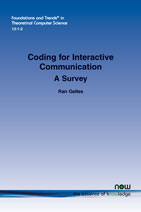Coding for Interactive Communication: A Survey
By Ran Gelles, Bar-Ilan University, Israel, Israel, ran.gelles@biu.ac.il
Abstract
Coding for interactive communication augments coding theory to the interactive setting: instead of communicating a message from a sender to a receiver, here the parties are involved in an interactive conversation. Coding schemes allow the parties to complete their conversation despite noise added by the channel. Similar to the unidirectional case, good coding schemes can withstand a large amount of noise and succeed with high probability, while adding only a small amount of redundant information. We aim at giving a comprehensive view on the foundations of coding for interactive communication. In particular, we review basic features of coding schemes in the interactive setting, and survey the main techniques used in designing such schemes. Furthermore, we survey recent developments in interactive coding schemes, and their applications to other related fields.
Coding for Interactive Communication: A Survey
Coding for interactive communication augments coding theory to the interactive setting: instead of communicating a message from a sender to a receiver, here the parties are involved in an interactive conversation. Coding schemes allow the parties to complete their conversation despite noise added by the channel. Similar to the unidirectional case, good coding schemes can withstand a large amount of noise and succeed with high probability, while adding only a small amount of redundant information.
Coding for Interactive Communication: A Survey provides the reader with a comprehensive view on the foundations of coding for interactive communication. In particular, it reviews the basic features of coding schemes in the interactive setting, and surveys the main techniques used in designing such schemes. It also surveys recent developments in interactive coding schemes, and their applications to other related fields.
